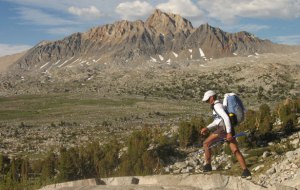Vagabond never had a positive connotation. Someone who walked from place to place, perhaps aimlessly, perhaps with purpose, but not really accomplishing much beyond survival.
Today some of the best and brightest are professional walkers. Hikers really. Actually backpackers. They walk with purpose and determination. They walk after planning their route carefully. Sending food by mail in advance to be picked up at a later date. Or have calculated where they can resupply food. Water sources have also been identified well in advance. And these modern vagabonds walk with one thing no vagabond of old could ever have imagined. They walk with sponsors. Gear supplied by this company. Clothes by another. Trip reports are beamed by satellite to a blog for armchair adventurers to follow. And sometimes they walk in the company of paying travelers who are happy to benefit from the company and experience of a professional hiker to lead the way.
And they walk for months at a time. Sometimes in a circle, around Mont Blanc or Alaska and the Yukon Territories. They walk from point to point, usually starting with the Appalachian Trail to gain experience than heading for the Pacific Crest Trail, or the Continental Divide Trail or Vermont’s Long Trail, or trails in Europe or Asia, like hiking from Kathmandu to Everest base camp. 
But unlike vagabonds of yore today’s modern incarnation have rehabilitated walking for survival to walking to thrive. And we who can not or do not take a long walk can see some of the world through their eyes. Two individuals who have elevated wandering to skillful art form are Andrew Skurka and Jennifer Pharr Davis. Both of these individuals have been named as National Geographic Adventurers of the Year, and not for skydiving from the stratosphere or hang-gliding from the top of Mt. Everest. But for walking.



